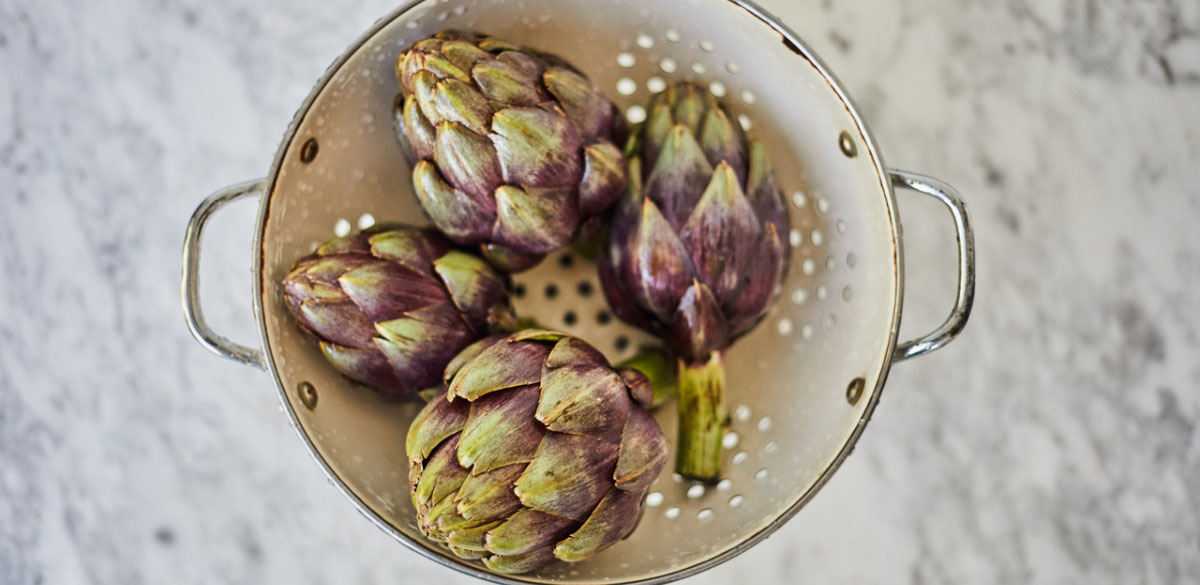They might look intimidating, but artichokes are simple and delicious. OK, I know they can be a little fiddly and they do need a lot of care and attention to prepare, but once you’ve got the hang of it, it’s easy and you’ll wonder why you never bothered to prepare and cook them before.
The artichoke has a long and interesting history. For many years, although it was cultivated and eaten in Italy, it was unknown in France. During the 17th Century, it was thought to be an aphrodisiac and women were not allowed to eat them! Fortunately, that myth is no longer believed. Artichokes are rich in fibre, vitamin C, potassium and folic acid, as well as being naturally fat and cholesterol-free. Moreover, the leaves of the artichoke are known to reduce levels of bad cholesterol and increase levels of good cholesterol (HDL or Omega-3 fatty acids).
After Italy, Spain is the largest producer of artichokes, growing about 30% of the world’s supply and is the major exporter. Several different varieties are grown around the world and cultivation is grouped geographically. In Spain, the type that is most widely available is known as “Blanca de Tudela”. The varieties vary slightly in shape, size and colour (green and/or purple). They are generally harvested in autumn and winter in Spain, although they can be found in markets through spring. When buying artichokes, look for ones that seem heavy for their size. Artichokes with a tight leaf formation are also preferred and the leaves should “squeak” when pressed together. Heavy browning on an artichoke usually indicates it’s past its prime. They do not keep very well in their fresh state but once cooked (traditionally in a Blanc), they will keep for 2-3 days.
So, is all the effort worth it? Absolutely! But the first step is to simply roll up your sleeves and get on with it. To prepare whole artichokes for poaching, pull off the lower, outer and discoloured petals. Trim the stem to form a flat base so that the artichokes will stand upright. Cut off one-fourth to one-third of the leaves straight across the top. Rub the cut surfaces with lemon juice to prevent browning. Stand the artichokes on their flat bases in a non-aluminium pot with about 2 inches of water, lemon juice and seasoning. Cover, and gently simmer the artichokes for 15-20 minutes. Once cooked, they should be eaten within 24 hours. If all that sounds like too much hard work, you could outsource the job entirely and start with jarred or frozen artichoke hearts.
Artichokes are incredibly versatile; they can be used as a garnish with other ingredients, or as a first course in their own right. They are fantastic in risotto, make a great soup and are often eaten with hollandaise or aioli. They also make great partners for potatoes, truffles, mushrooms, bacon and anchovies. In Italy, raw baby artichokes are finely sliced and tossed in olive oil, lemon juice and shaved parmesan to make an excellent appetiser that’s bitter, sharp and salty. Here in Spain, they are known as “Alcachofas” and the Spanish love them fried with Serrano ham and garlic. In my recipe, I’ve added wild mushrooms, truffles (optional) and a little dry sherry.
ARTICHOKES WITH WILD MUSHROOMS, TRUFFLES & SERRANO HAM
Ingredients Serves 4
8 globe artichoke hearts, cooked (you could use good quality artichokes from a jar)
80g Serrano ham, diced
200g mixed wild mushrooms, cleaned and chopped
8 thin slices of fresh truffle (optional)
1 medium onion, finely chopped
3 garlic cloves, crushed
Juice of one lemon
2 Tbsp chopped chives
120ml dry sherry or white wine
150ml vegetable stock
1 Tbsp flour
4 Tbsp olive oil
Seasoning
Quarter the artichokes and scoop out the hairy centre with a spoon. Heat the olive oil in a large frying pan over a medium heat. Sauté the onion and garlic until soft and add the wild mushrooms and Serrano ham. Cook for 1-2 minutes, then add the flour and stir well. Add the dry sherry and vegetable stock, stir well and cook for about 2 minutes until the sauce thickens. Add the artichokes and lemon juice and warm them through. Scatter with sliced truffles and chopped chives. Season to taste and serve immediately.



















0 Comments